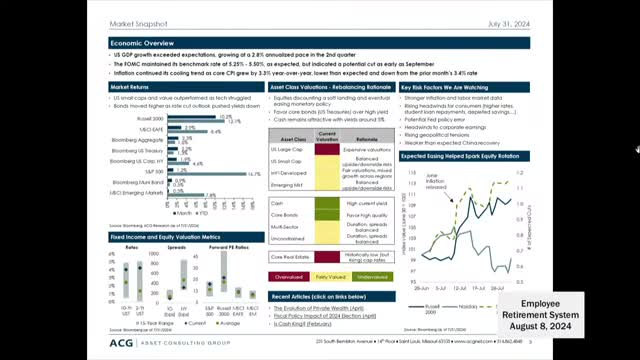Market Volatility Sparks Concerns Amid Small Cap Rally
August 08, 2024 | Public Employees Retirement System, Executive, Oklahoma

This article was created by AI summarizing key points discussed. AI makes mistakes, so for full details and context, please refer to the video of the full meeting. Please report any errors so we can fix them. Report an error »

In a recent government meeting, significant discussions centered around market volatility and investment strategies, particularly in light of recent economic indicators. The meeting highlighted a notable shift in market performance, with small-cap stocks emerging as the best-performing asset class in July, rising by 10%. This rally was attributed to expectations of the Federal Reserve lowering interest rates as inflation figures showed improvement.
However, the optimism was tempered by a disappointing jobs report released on Friday, which indicated fewer new jobs than anticipated. This, combined with Japan's central bank's decision to raise interest rates for the first time in two decades, led to a significant market sell-off as investors unwound carry trades. As a result, the beginning of August has been marked by increased market trepidation.
The meeting also addressed the portfolio's asset allocation, noting a strategic shift from equities to fixed income. The target allocation for equities was reduced from 65% to 60%, while fixed income was increased from 20% to 25%. This rebalancing is part of a broader strategy to mitigate risk and enhance returns, particularly in light of the recent market fluctuations.
Despite the challenges, the portfolio has shown resilience, with a one-year return of 8%, surpassing the hurdle rate of 7%. However, it remains behind the policy index, primarily due to the significant allocation to the S&P 500, which has outperformed small-cap stocks over the past year.
The meeting concluded with a motion to receive the monthly and quarterly investment reports, both of which were approved. As the trust meeting transitioned into executive session, the discussions underscored the ongoing complexities of navigating investment strategies amid fluctuating market conditions.
However, the optimism was tempered by a disappointing jobs report released on Friday, which indicated fewer new jobs than anticipated. This, combined with Japan's central bank's decision to raise interest rates for the first time in two decades, led to a significant market sell-off as investors unwound carry trades. As a result, the beginning of August has been marked by increased market trepidation.
The meeting also addressed the portfolio's asset allocation, noting a strategic shift from equities to fixed income. The target allocation for equities was reduced from 65% to 60%, while fixed income was increased from 20% to 25%. This rebalancing is part of a broader strategy to mitigate risk and enhance returns, particularly in light of the recent market fluctuations.
Despite the challenges, the portfolio has shown resilience, with a one-year return of 8%, surpassing the hurdle rate of 7%. However, it remains behind the policy index, primarily due to the significant allocation to the S&P 500, which has outperformed small-cap stocks over the past year.
The meeting concluded with a motion to receive the monthly and quarterly investment reports, both of which were approved. As the trust meeting transitioned into executive session, the discussions underscored the ongoing complexities of navigating investment strategies amid fluctuating market conditions.
View full meeting
This article is based on a recent meeting—watch the full video and explore the complete transcript for deeper insights into the discussion.
View full meeting
